|
|
| |
|
The identification of a distant stint – Norfolk's first Least Sandpiper Steve Gantlett
At about 9.30am on 7th July 2016, I was in Teal Hide at Cley Marshes NWT Reserve, Norfolk, when I noticed a stint creeping about on some wet mud amongst some long grass out on Pat's Pool. Unfortunately it was some 200 yards away and looking towards Bishop's Hide opposite, so southeast and straight into the light. It was fiercely sunny and there was already a heat-haze, so viewing conditions were horrendous. On top of this, the bird was creeping about slowly over a very small area and spent more than 90% of its time hiding in the grass. Unfortunately, in this position it would not have been viewable from Bishop's Hide (from which direction the morning light would have been much better). With my 25-50x65 Leica scope, the bird did look interesting. It was creeping about like a Temminck's Stint, but it seemed it might be a little bit dark and rather neatly patterned on the back for a typical adult Temminck's, and it seemed rather boldly and darkly streaked on the breast too. But the viewing conditions really were so horrendous that it was difficult to be sure of anything. If it was something more interesting than a Temminck's, I needed even more optical fire-power and some help. I hurried home for my 50-80x Questar scope and informed Richard Millington that I had a possibly interesting stint. Within 10 minutes I was back again in Teal Hide, and RM joined me with his 20-60x80 Swarovski scope. The views were a little larger with the higher-powered scopes, but the bird spent even more time hiding and the heat-haze became worse and worse. Nevertheless, the bird continued to look somewhat interesting, so we persevered. I notified other local birders that we had a potentially interesting stint and Trevor Davies soon joined us. Despite watching till nearly 1.00pm, however, the bird came no closer and we obtained no more detail. The bird was behaving like a Temminck's, however, and we gathered that some worn adult Temminck's can be surprisingly dark-plumaged, while, importantly, we established that the bird's tail projected beyond its wing-tips. We discussed Long-toed Stint and Least Sandpiper, the only other pale-legged candidates, but Long-toed was eliminated on shape alone; there was no uprightness to its stance. There is a large format Collins Bird Guide in the hide, so we consulted that, and it confirmed what we thought we knew about Least Sandpiper; a species characterised by its very short tail-end – the rear end of our bird was clearly attenuated, as would be normal for Temminck’s Stint. Also, in the glare, its legs looked just pale yellowish, not the quite bright yellow we associated with Least Sandpiper. And then there was its feeding habit: it had a very slow and deliberate, creeping gait, which we associated with Temminck's, and not the more lively picking action we expected of Least.It was impossible to ascertain the exact pattern of the upperparts but, even so, we seemed to have established that the bird really had to be just an unusually dark-plumaged Temminck's, so I phoned out that identification just before 1.00pm. We still had some lingering doubts, however, and I planned to come back again for another look later in the afternoon, when the sun had come round to a more favourable angle, the heat-haze had died down and the views would surely be much better. Unfortunately, however, the bird had gone when I returned at about 4.00pm and it was not seen again, despite birders looking for it from then and right through the evening. It seemed to have moved on. TD did a quick Google search and instantly found a quite dark-looking July Temminck's Stint (taken on Scilly by Martin Goodey on 29th July 2011) that seemed to match our bird quite well: http://www.surfbirds.com/gallery/search2.phpspecies=stint&photographer=&location=&country=&start=101 |
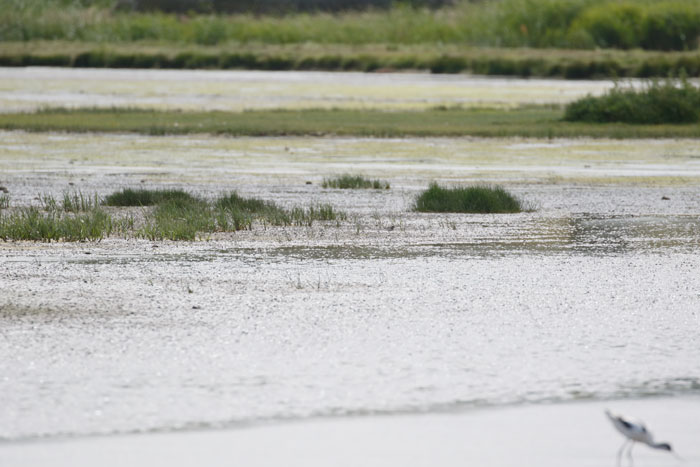 |
| Here is the bird – just right of centre – full frame, taken with a 400mm lens and a 1.6x camera body. This equates to approximately the binoculars view. The bird is in the open here, but spent 90% of its time hiding in the grass to its left here. |
|
That seemed to be that, but then I visited Daukes Hide with Sue at about 11.00am the next day, and there
it was again: mostly hiding in the grass again exactly where
it had been the previous morning. James McCallum was already in
Daukes, but had not yet seen the bird (hardly surprising as it
was hiding in a distant patch of grass most of the time), so I pointed
it out to him and phoned it out as 'the Temminck's Stint again
on Pat's Pool'.
Unfortunately it was bright and sunny again and the light and viewing conditions were just as appalling as on the previous morning. I was using my 25-50x65 Leica scope again and could ascertain nothing additional to my previous views, so I left James watching and videoing it, while I planned to return later, once again hoping that it would be viewable in the afternoon when the sun had gone round. I did not realise, but JM had no knowledge of the previous day's debate, so he explains his independent reaction to seeing the bird in the appendix at the end of this article. There was no more news on the bird after my update, but I returned to Teal Hide in the mid afternoon and there was no sign of the bird. Neither did it come out of hiding in the evening and it was not seen again. That really did seem to be that. I looked at my photos, blown up to the maximum and they really did not seem to show much detail but, actually, they did not show the bird being all that dark, and they certainly did not show the typically bright yellow legs of Least Sandpiper. |
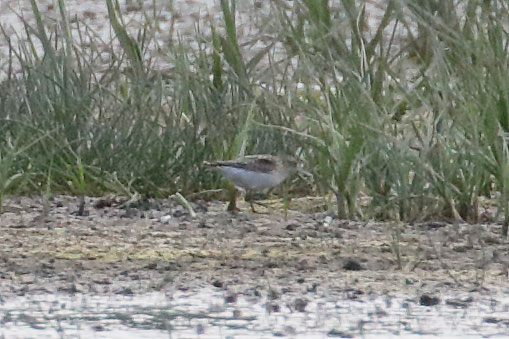 |
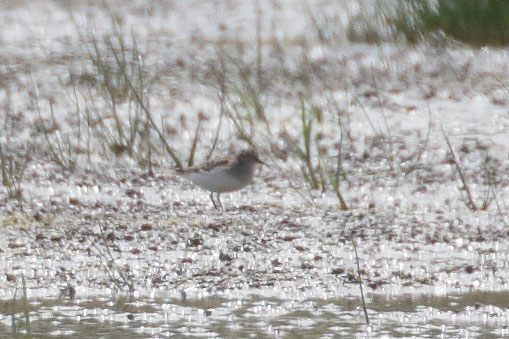 |
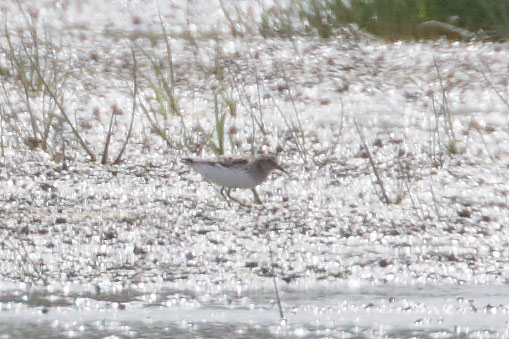 |
| The above are my best three photographs of the bird. These equate to approximately my best telescope views. Very little detail, but note the somewhat attenuated and slightly pot-bellied appearance. |
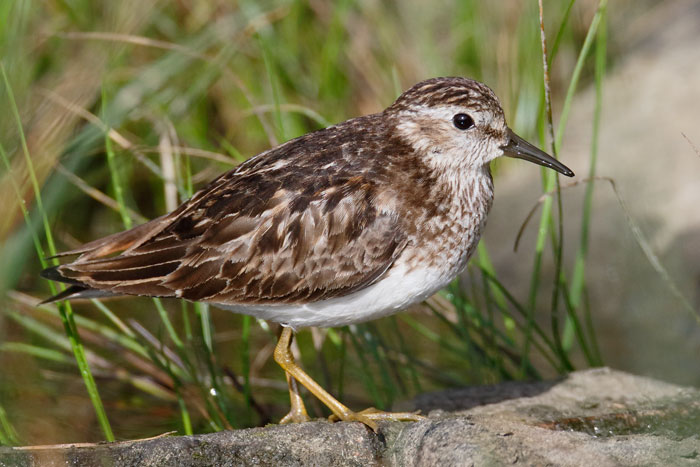 |
| But this is how dark-plumaged and bright-legged I was expecting a Least Sandpiper to be: the bird I photographed in Co. Clare, Ireland, on 19th August 2016. It looks typically front-heavy and short in the rear. |
| Much later I learned that James had remained watching and videoing the bird from Teal Hide until about 1.00pm on 8th when the bird moved from its chosen spot and went out of sight in the middle of the scrape, and that Nigel Rogers had arrived just as he was leaving. The bird obviously reappeared for Nigel before too long and he took some photographs of it. He later posted one of his photos on the Cley Bird Club website (captioned Temminck's Stint) but I was unaware of this. It seems that, throughout, no-one saw the bird in flight or saw the spread tail pattern detail. |
|
|
| Nigel Rogers' photo taken on the afternoon of 8th July, as posted on the Cley Bird Club website. |
|
Mark Golley (who was away from Cley and working in Paris at the time), however, apparently spotted Nigel's photo on the Cley Bird Club website and instantly realised that, although still very far from ideal, the bird looked more like a Least Sandpiper than a Temminck's Stint! It had clearly been a bit closer and in rather better light when Nigel photographed it. Mark corresponded with JM who shared his video-grabs with him and analysis of these together with NR's photo fuelled the doubts. The evidence was shared with RM, who sent the NR's photo-link and JM's video-grabs to Killian Mullarney for his expert opinion. |
|
|
|
|
|
|
|
|
|
|
|
|
|
|
|
|
|
|
|
|
| James McCallum's video-grabs taken on the late morning of 8th July 2016. |
|
Killian replied enthusiastically that, while thoroughly appreciating how perplexing it must have been trying to identify the bird in the field when the views were so poor, he believed that there was sufficient detail in NR's photo and the video-grabs that the bird could be identified with confidence as a Least Sandpiper. Killian noted that, as James had already concluded, a Temminck's exhibiting one anomalous feature is one thing, but as this bird shows several anomalous features for Temminck's, all of which are suggestive of Least, it clearly requires very critical analysis, especially of any features that are deemed to be an obstacle to it being a Least. As an aside, KM noted that the treatment of Least Sandpiper in the Collins Bird Guide reflected the understanding at the time, but did not extend to an appreciation of the real similarity between Least Sandpiper and some heavily-marked adult-breeding Temminck's Stints. KM went on to say: 'Early in the identification process, with so little plumage detail being visible, much weight was put on the fact that the bird clearly had a projection of the tail beyond the wing-tips and that this was considered to be a strong pro-Temminck's feature, but actually, having checked a lot of tail:wing-tip ratios, I think there is a good deal more variation in the two species than I believed at one time, with significant overlap; while I have yet to see a Least with as long a tail-projection as is typical in Temminck's, it seems not to be exceptional for Least to have a short tail-projection, similar to your bird. Furthermore, I do not see your bird as being quite as 'long-bodied' as Temminck's, though I accept that this is a very subjective evaluation, very much 'in the eye of the beholder'. The analogy I would make is that the shape of Temminck's often reminds me of Baird's Sandpiper, whereas even long-tailed Leasts seem to have a rather dumpy, compact appearance.' 'Since I don't have any difficulty reconciling the shape of your bird with a (long-tailed) Least, I perhaps more easily identify the plumage features with Least too. I don't think I have ever seen a Temminck's, either in life or in a photo with such a strongly marked head, incorporating pale lateral crown-stripes (or split supercilium if you prefer) and prominent supercilium behind the eye; in one or two of the grabs the markings are almost reminiscent of a Broad-billed Sandpiper! Similarly, the well-marked breastband with lines of arrowhead-like streaks, at least a suggestion of pale mantle-stripes, as well as a rather prominent pale scapular-stripes (on the third/fourth rows) are indicative of Least. Well-marked Temminck's (individuals with a lot of 'summer patterned' scapular and mantle feathers) often develop prominent, pale internal markings on the larger scapulars, but it seems to be very rare for them to show such a prominent pale scapular stripe, formed by the tips of the third row and bases of the fourth row, as is commonly seen in adult Least; usually the pale-based feathers are scattered more liberally throughout the scapulars. I have yet to find evidence that Temminck's can ever show distinct mantle-stripes.' 'One more feature that I think is indicative of Least is the shade of the outer tail feathers, though I would concede that in photos of this quality, interpretation of such detail is very tenuous indeed. In Temminck's, the outer tail feathers are white, and often eye-catchingly so, if the tail-sides are visible and the rectrices are slightly spread. There is usually no contrast between the outer tail feathers and the white lateral tail coverts. In Least, and other peeps there is often a detectable contrast between the lateral tail coverts and the outer tail feathers; I think I see a suggestion of this slight contrast in some of the images of the Norfolk peep.' |
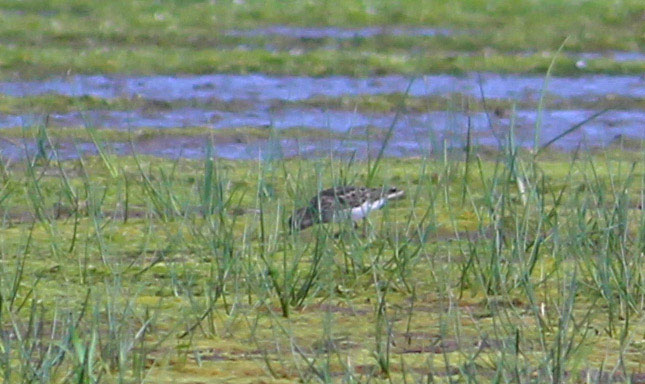 |
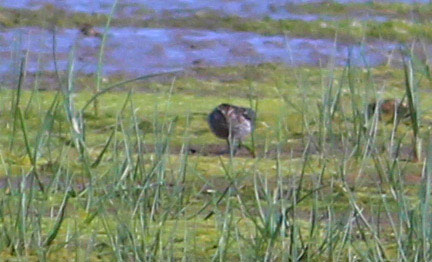 |
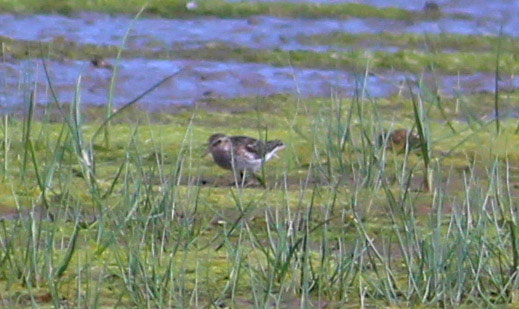 |
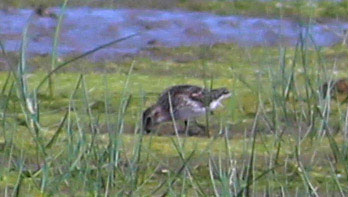 |
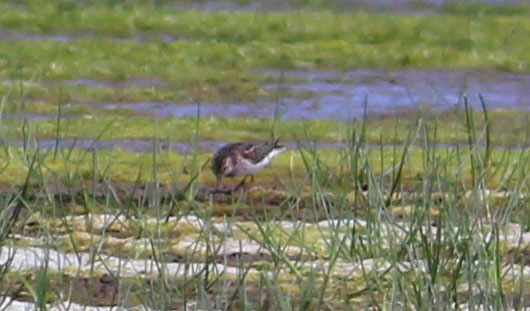 |
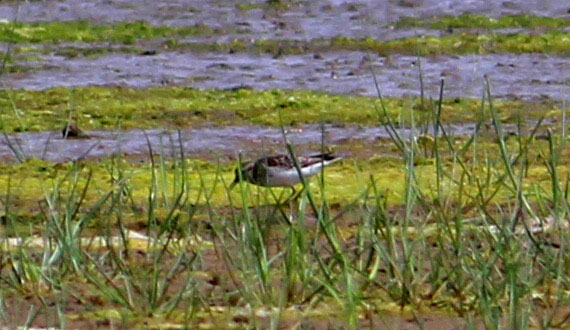 |
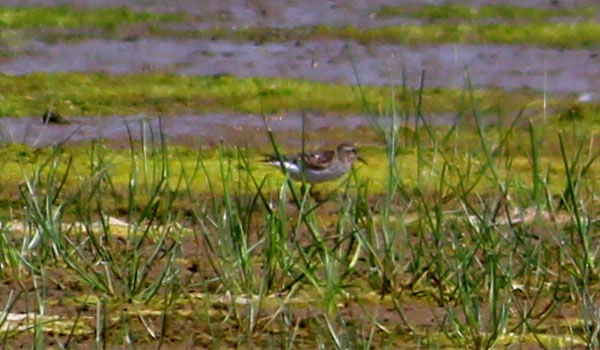 |
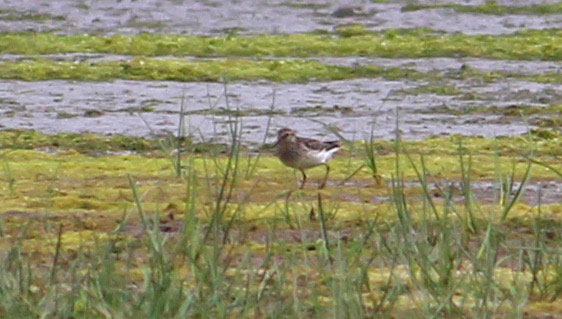 |
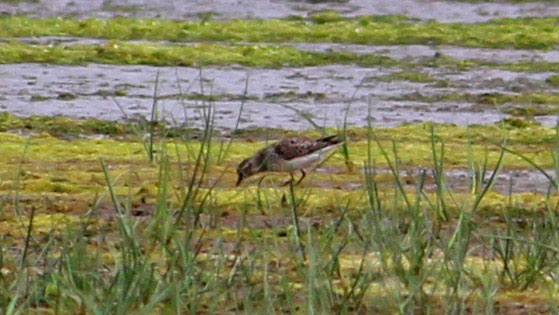 |
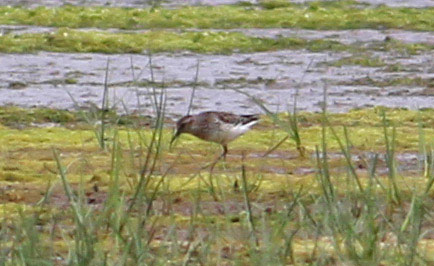 |
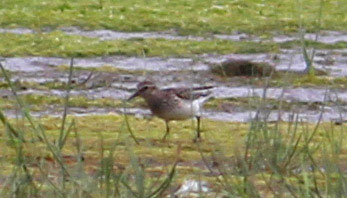 |
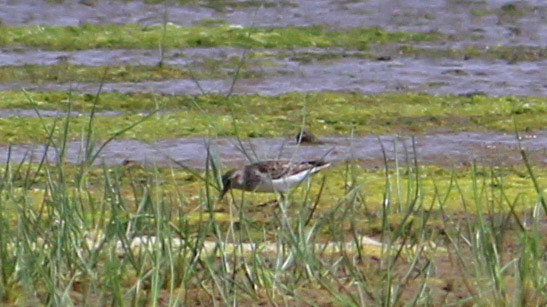 |
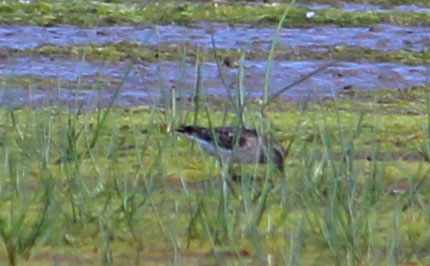 |
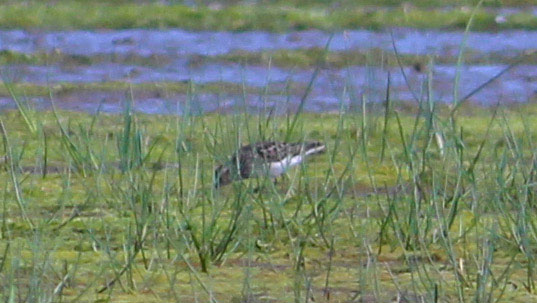 |
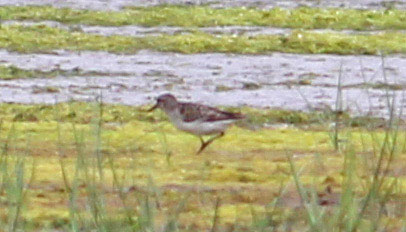 |
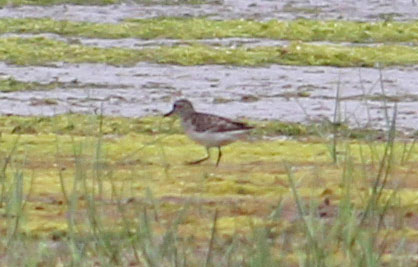 |
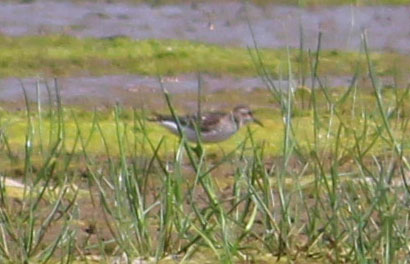 |
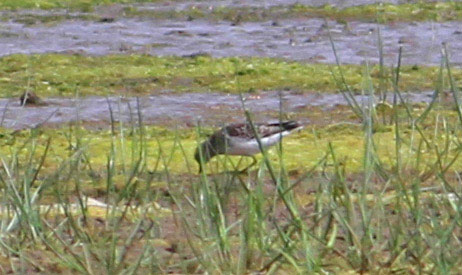 |
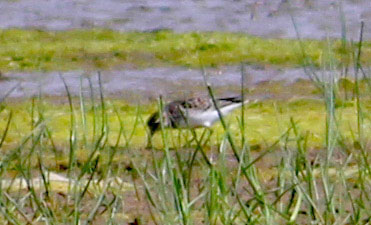 |
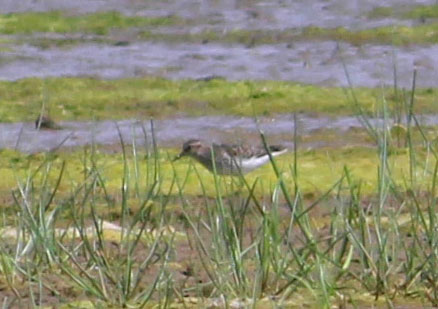 |
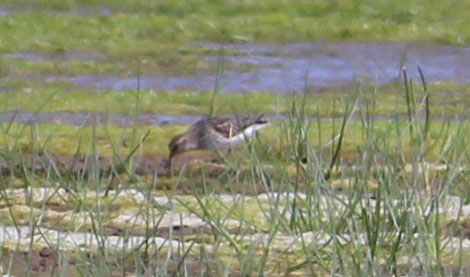 |
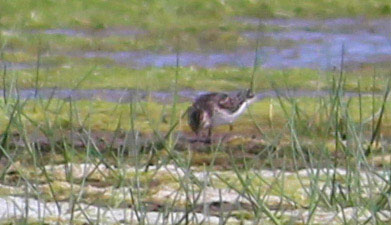 |
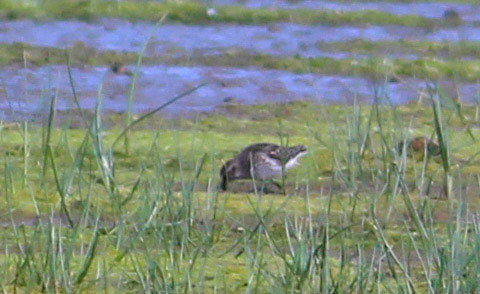 |
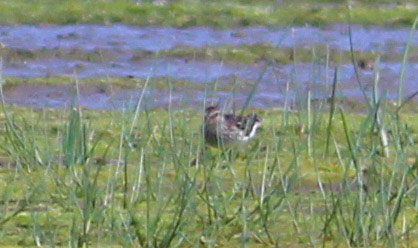 |
| These are the rest of Nigel Rogers' photographs of the bird, taken during the early afternoon of 8th July. While he was still in the hide looking at these photos on the back of his camera, the bird apparently flew off and it was not seen again. He took this wide range of shots due to the uncertainty about the bird, but based on structure he considered there appeared no reason at the time to dismiss Temminck's Stint. |
|
NR also found evidence of some worn adult Temminck's Stints showing quite darkly contrasting breast streaking, ie a bird photographed in Cyprus in August, plate 66.2 in (Paulson 2005) Shorebirds of North America, and the flight photograph plate 66.6 in the same book seems to show this too. This article is intended to present the chronology of events surrounding this tricky bird. It is not intended to be a full discussion of its identification, although all the photographic evidence is here for anyone interested to see. Full details of the bird will be sent to BBRC for assessment and, if they agree that the evidence is strong enough, this is likely to be accepted as the first record of Least Sandpiper for Norfolk. It is just such a shame and most unfortunate that it did not show itself much better. It is interesting, perhaps, that there have been four other records of Least Sandpiper in Britain & Ireland during July & August 2016, making it an exceptional time for this species – indeed, almost an influx. Steve Gantlett 5th September 2016 Stop Press: July 2017, the record has now been accepted as Norfolk's first Least Sandpiper. Appendix: JM gives his independent reaction on seeing the bird late morning on 8th July: 'During the early part of the summer I had been sketching the development of Little Ringed Plover chicks that were nesting on Blakeney Point. The morning of the 8th July had started wet so I delayed my visit to watch them and decided to nip into the hides at Cley. I had seen on Bird Guides the previous evening that a Temminck’s Stint had been reported and felt there was also the chance that something else may have been grounded by the rain. I had scanned the scrapes several times but couldn’t find the stint and was happily watching recently-returned Green Sandpipers when Steve and Sue Gantlett entered the hide. Steve asked if I’d seen the Temminck’s to which I replied ‘No, sadly not’. He then proceeded to sit down and immediately locate the bird! It was apparently feeding in the same area that it had frequented the previous day and looking through my telescope there was little wonder why I hadn’t seen it as it was essentially a dot creeping about amongst vegetation. We decided to move to Teal hide where we were joined by three other birders, the bird was marginally closer but viewing was directly into the sun. The rain clouds had cleared and the hot July sun had burst through quickly creating heat shimmer from the rain-soaked marsh. The viewing conditions were therefore pretty awful; even so, on focusing my telescope, I was slightly taken aback by the bird’s appearance. The first thing that struck me were the neatly arranged scapulars and although it was pretty difficult to see detail clearly each one seemed to have a solid dark centre which didn’t quite tie in with my past experience of Temminck’s. It’s difficult to articulate just how difficult the bird was to view, not just because it was creeping about in vegetation but also the poor lighting conditions. Occasionally it was possible to catch a glimpse of details of the bird’s plumage - most often as the bird turned and caught the light. After ten minutes of silent, concentrated viewing I had glimpsed further odd features such as hints of a couple of pencil-fine streaks on its rear flanks, a heavily-streaked crown and seemingly a few arrowhead markings on the beastsides. I was still slightly taken aback and remarked to Steve that I found the bird’s plumage ‘very odd’ and mentioned the features that I’d seen. Further concentrated watching resulted in tantalising glimpses of what appeared to be traces of a broken mantle ‘V’ (especially on the left-hand side) and, again as the bird turned and caught the light, the impression of a split supercilium. I openly expressed my thoughts stating that I was a little ruffled by what I’d seen and openly asked the question ‘Why isn’t this a Least Sandpiper?’ It then transpired that Steve had gone through a similar process the previous day and in his reply he then highlighted the bird’s structure – it certainly did consistently look to have a long rear end and, in addition to this, regularly showed a distinct tail projection. I thought back to my only other encounter with Least Sandpiper – an afternoon spent watching adults tending chicks on the Alaskan tundra. My lasting impression of Least Sandpiper was that of an attractive small, dark peep with a curious short rear-end and dumpy jizz. This impression clearly matched Steve’s experience of Least Sandpiper and we both felt that the structure of the bird seemed a much better fit for Temminck’s. But there was still the question of the bird’s unusual plumage... By chance I had brought with me my old Sony video camera with the intention of capturing some footage of the Little Ringed Plover family as the chicks were the first ever to be hatched on Blakeney Point. The stint’s plumage puzzled me enough to dig it out of my bag and attempt to obtain some footage by filming through my telescope. So we were faced with a strange situation - a distant small wader in the heat haze that appeared to show a plumage that didn’t quite match our previous experience of Temminck’s Stint and seemed a better fit for Least Sandpiper but with a structure that didn’t fit our experience of Least Sandpiper. There is a copy of the Collins guide in the hides at Cley and Steve brought it over - the text and illustrations suggested that the structure was far closer to Temminck’s Stint. I’d even briefly noted a slight notch on the fringe of one of the longest greater coverts and it was easier to match this to the illustrations of Temminck’s than it was to those of Least – but this later proved to be something present in both species. I went ‘hot and cold’ over the bird’s identification for the next fifteen minutes until a further, in many ways unfortunate, chain of events changed my perception of the bird – At last it walked free of the vegetation and onto open dark oozy mud. When viewed against the dark mud, harshly backlit by the sun, the bird’s plumage instantly looked pretty pale and suddenly lacking in contrast. The structure remained that of a stint with a long rear end and it now consistently showed a short, but distinct, tail projection. It appeared to struggle to walk through the thick wet mud and the slow creeping action combined with the sudden impression of a less contrasting more uniform plumage swayed me more towards Temminck’s Stint – one I presumed with a less typical, heavily-worn plumage. This too was Steve’s conclusion and shortly afterwards he and Sue left along with the other birders leaving me alone in the hide to wrestle with my thoughts. The bird’s appearance could change dramatically - in the open it looked pale and fairly bland but at other times it could suddenly look much more contrasting again - I was thinking ‘Where’s Mark Golley when you need him!’ He would have enjoyed debating the bird but unfortunately he was away working. I jotted down a few notes and made a few basic sketches in an attempt to capture both the field impression and the interesting plumage details that I’d noted then reverted to videoing the bird. There was one interesting aspect of behaviour that I noted when a juvenile Cuckoo flew along the edge of the scrape and alarmed some of the waders. In a situation such as this I’d expect a Temminck’s Stint to crouch low to the ground but instead this bird stood quite erect and raised its head high (very much in the manner that Long-toed Stints are said to do) then quickly relaxed again and continued feeding. A little later all the birds were spooked again and, annoyingly, the stint had taken flight before I could get on it so I was unable to see the tail detail. I picked it up again even further away on mud in front of a dark earthy bank. To be perfectly honest at this range and in this setting the bird looked very much like a Temminck’s in both plumage and structure. The bird then wandered out of view and I’ll hold up my hands and admit that, although still slightly ruffled by its odd plumage and despite my earlier reservations, I concluded that Temminck’s did indeed appear to be a better fit. I then decided to leave and planned to research the variation in the plumage of worn midsummer Temminck’s Stints. I had lots of experience of Temminck’s in June from past sketching trips and survey work in the North and Arctic but I’d very little experience of what worn birds in midsummer could potentially look like. It was now around lunchtime so I just had enough time to have a quick check of the Little Ringed Plovers before I had to collect my daughter from school. On leaving the hide I met Nigel Rogers who had come to see the bird – I mentioned that I’d seen the bird and remarked how odd it looked. So that was my experience of watching the bird in the field so I can fully appreciate the difficult viewing conditions that Steve faced when he discovered the bird. Although I had a trawl through the internet for midsummer Temminck’s late that evening, I didn’t get a chance to look at the video footage until breakfast time the following morning. My first feelings were of pleasant surprise that the ‘vintage’ camera had surprisingly managed to capture all of the bird’s plumage features. Everything I had noted in the early stages of observation were caught on film – suggestions of arrowheads on the breastsides, fine streaks on the flanks, crown pattern, hints of a mantle ‘V’...etc. - indeed some appeared better resolved than it was possible to see in the field. The feeling of pleasant surprise was quickly overtaken by the same uneasiness that I experienced when I first viewed the bird at Cley. As I was heading towards Cley on my way to see the Little Ringed Plovers I checked Bird Guides to find out if the bird was still present but there had been no further sightings since the previous afternoon. I puzzled over the plumage and structure again and started to search the internet again for images of both species. I failed to find any images of a Temminck’s that showed the complete range of plumage features that I’d noted in the field and were now confirmed by the video-grabs – My thoughts were starting to drift back to Least Sandpiper but equally I was struggling to find images of adult Leasts with a similar structure so I was still no further ahead. A week or so later a series of vagrant Least Sandpipers began turning up in Britain – the first was in Devon and a series of excellent images and videos of the bird started appearing on the internet. There were undoubtedly some similarities in plumage to the Cley bird, but images and footage showing the Devon bird’s structure very much conformed to the birds that I’d seen in Alaska and therefore tied in well with Steve’s experience too – so the Cley bird remained puzzling! Once Mark had returned to Norfolk we began discussing the bird and tried to resolve the issue of why the plumage seemingly appeared to conflict with the structure. Mark had already noticed Nigel Roger’s single photo of the bird posted on the Cley Bird Club website and was alarmed and puzzled by the appearance of the bird but he was wary of placing too much importance on a single image. I shared my video-grabs with him and we continued to debate the identification. The bird was long gone so there was no urgency in reaching a conclusion. Mark noted many pro-Least features but much of our discussions revolved around my sticking point - plumage Vs structure. The ID process, however, progressed speedily once the images were passed on to Killian Mullarney for his thoughts. In most current literature concerning stint and peep identification plumage and structure seem to be largely supportive of each other but in the case of the Cley bird, to me, they appear to conflict – in an email to Killian I mentioned that when trying to ID the bird in the field it felt as if I’d reached an unexpected but definite fork in the road (With the luxury of hindsight I seemingly took ‘the wrong fork’ midway through my observation at Cley). I concluded that I could accept the bird being a Least on plumage, that was never my main issue, but with my limited experience I struggled to imagine a Least ever looking as long-bodied as that. Killian with his acute eye for detail and far greater experience had no trouble reconciling the structure in favour of Least. I’m stuck with being one of those personality types that prefers to base conclusions on firsthand field experience so without guidance from those with more experience I would still be struggling with the notion that a Least Sandpiper could exhibit the same structure as the Cley bird. That said I have since seen a few videos of summer adult Leasts that do indeed show rather long rear-ends and clear tail projections - but in an ideal world I would rather spend some time in the field watching feeding Least Sandpipers and compare this experience to that of watching the Cley bird. It seems that I’ve clearly a huge gap in my experience of the structure of Least Sandpipers and it appears that this is mirrored in much literature too.'
|